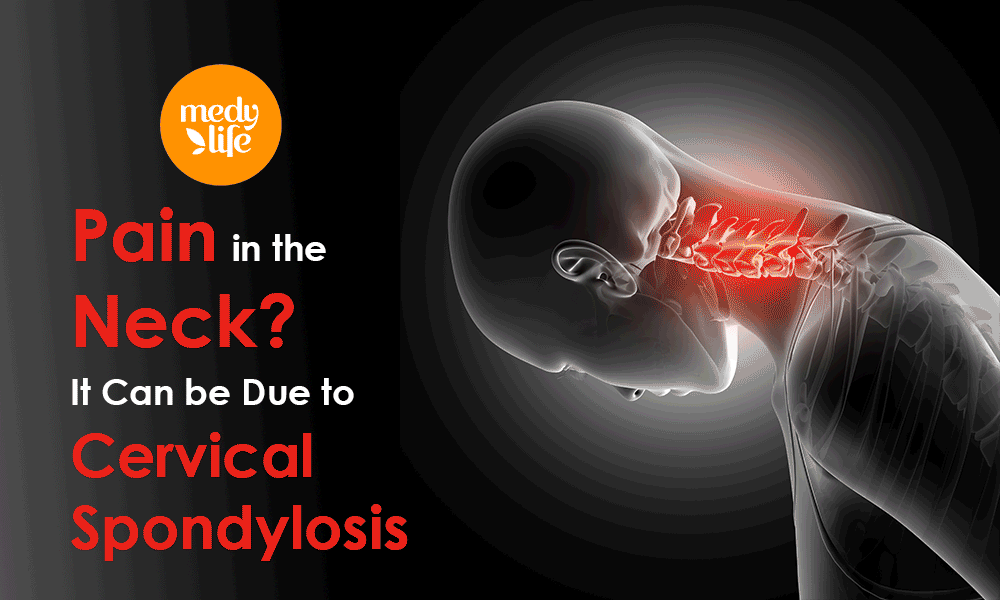
Pain in the Neck? It Can be Due to Cervical Spondylosis
29-06-2018 | Posted By: Chhavi | 4605 View(s)
Recurring pain in the neck can be a sign of cervical spondylosis. Cervical spondylosis is a common condition that affects the joints and discs in the cervical spine, which is in your neck. This condition is also known as neck arthritis or cervical osteoarthritis. This results due to wear and tear of bones and cartilage. Ageing is one of the factors that contribute to this condition, but it can be caused by other factors as well.
Cervical spondylosis can also cause severe pain and stiffness. One of the most common symptoms of cervical spondylosis is neck pain. If you experience pain in the neck on a regular basis, consult a doctor and get a health checkup done. There are many causes of this condition. Let us understand causes, symptoms, and treatment of cervical spondylosis.
What Causes Cervical Spondylosis?
The wear and tear of bones and protective cartilage in your neck can cause cervical spondylosis. Some of the leading causes of cervical spondylosis include:
1. Bone Spurs
When our body tries to grow extra bone to make the spine stronger, it results in overgrowth of bone. The extra bone puts extra pressure on delicate areas of the spine, resulting in pain.

2. Injury
Neck injuries can also lead to cervical spondylosis.
3. Ligament Stiffness
The tough cords connect the spinal bones in our body. These tough cords can become stiff over time, which affects the neck movement and makes the neck feel tight.
4. Dehydrated Spinal Discs
There are discs in between your spinal bones. These are thick, pad-like cushions and absorb the shock of twisting, and other activities. The gel-like material present inside these discs can dry out over time. This can cause the bones to rub together more, which can be painful and cause cervical spondylosis.
5. Herniated discs
Spinal discs can develop cracks, which can lead to the leakage of the internal cushioning material. This material press on the nerves and spinal cords, causing symptoms such as arm numbness and neck pain.
What are the Major Risk Factors for Cervical Spondylosis
One of the biggest risk factors for cervical spondylosis is ageing. Dehydration, bone spurs, and disc herniation are all results of ageing.
Some other leading factors that can increase your risk of cervical spondylosis are:
• Neck injuries
• Activities that put extra strain on your neck
• Holding your neck in a position which is uncomfortable for prolonged periods
• Genetic factors
• Smoking
• Being obese/overweight or inactive
What are the Symptoms of Cervical Spondylosis
Many people with cervical spondylosis do not experience any symptom. If symptoms do occur, they may develop gradually or occur suddenly and can range from mild to severe.
One common symptom of the condition is pain around the shoulder blade. The pain might increase when standing, sitting, coughing, sneezing and tilting your neck backward.

Other signs of the condition include:
• Muscle weakness
• Headaches in the back of the head
• Tingling in shoulders and arm
• Neck pain
• A stiff neck
• Loss of balance
• Loss of bladder
If you experience any of the symptoms as mentioned above, consult a doctor immediately.
How is Cervical Spondylosis Diagnosed and Treated
The diagnosis of this condition involves testing for movement and determining the affected bones, nerves, and muscles. Your doctor will first conduct a physical exam and then ask you several questions regarding symptoms.
Some of the tests that are recommended to confirm the diagnosis are:
1. X-Rays
2. CT scan
3. An MRI scan
4. An electromyogram (EMG)
Treatments for cervical spondylosis include physical therapy and medications. If the condition is severe, the patient might need surgery. However, the treatment gets started with physical therapies which help the patients to stretch their neck and shoulder muscles.
This makes their muscles stronger and helps relieve pain. The doctor might also prescribe certain medications if over-the-counter drugs do not work. There are also many highly effective home remedies that help treat cervical spondylosis.
What are The Best Home Remedies to Treat Cervical Spondylosis
1. Garlic
Eat two to three raw garlic buds on an empty stomach every morning with water. Alternatively, heat a few crushed garlic cloves in a pan with some vegetable oil. Let it cool and use this to massage the painful area for five minutes.
Follow this with a warm bath. Do this once a day to get rid of the pain. Garlic has analgesic and anti-inflammatory properties that help treat swelling, inflammation, and pain in the neck and surrounding areas.
2. Sesame Seeds
Take a few drops of warm sesame oil and massage it on the affected areas for about 10 minutes. Apply a hot compress on the area. Do this twice a day.
You can also mix sesame oil with lavender oil and use this mixture to massage the neck area.
Alternatively, mix one teaspoon of roasted and ground sesame seeds in a glass of warm milk and drink this two times a day. You can include sesame seeds in your cooking too.
Sesame seeds are enriched with manganese, copper, zinc, vitamin K, magnesium, and vitamin D which keeps your bones healthy. Sesame oil also helps in reducing neck pain.
3. Exercise
Stand straight and rotate your head in both clockwise and counter-clockwise directions. Do this for ten minutes two to three times daily. You can also rotate your arms in clockwise and counter-clockwise directions, and fold and unfold your fists at regular intervals to get relief from pain.
You can even enjoy aerobic exercises like jogging, swimming, and brisk walking for half an hour at least five times a week.
Lack of physical activity is one of the primary causes of cervical spondylosis. You can reduce stiffness and pain around your neck and shoulders by doing exercise daily.
4. Hot and Cold Compress
Wrap a hot water bag in a thin towel to make the hot compress. To make the cold compress, you need to wrap a few ice cubes in a thin towel. Now place the hot compress on the affected area for a couple of minutes. Remove it and then apply the cold compress for one minute. Repeat this process for about 15 – 20 minutes.
Note: Do not apply cold compress if you have circulatory problems. Don’t apply hot compressing if the affected area is red, irritated, and swollen.
5. Ginger
Take a few drops of ginger oil and massage the affected area with this two to three times daily. You can also drink ginger tea daily. Boil one tablespoon of thinly sliced ginger in two cups of water for 10 minutes. Strain, add honey and drink this.
Ginger has anti-inflammatory properties which help improve blood circulation. Therefore, it helps in reducing pain and inflammation in the neck and surrounding areas.
Try these tips to get relief from cervical spondylosis. Consult a doctor if you experience symptoms of cervical spondylitis.


